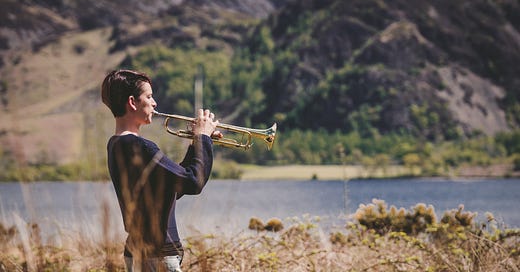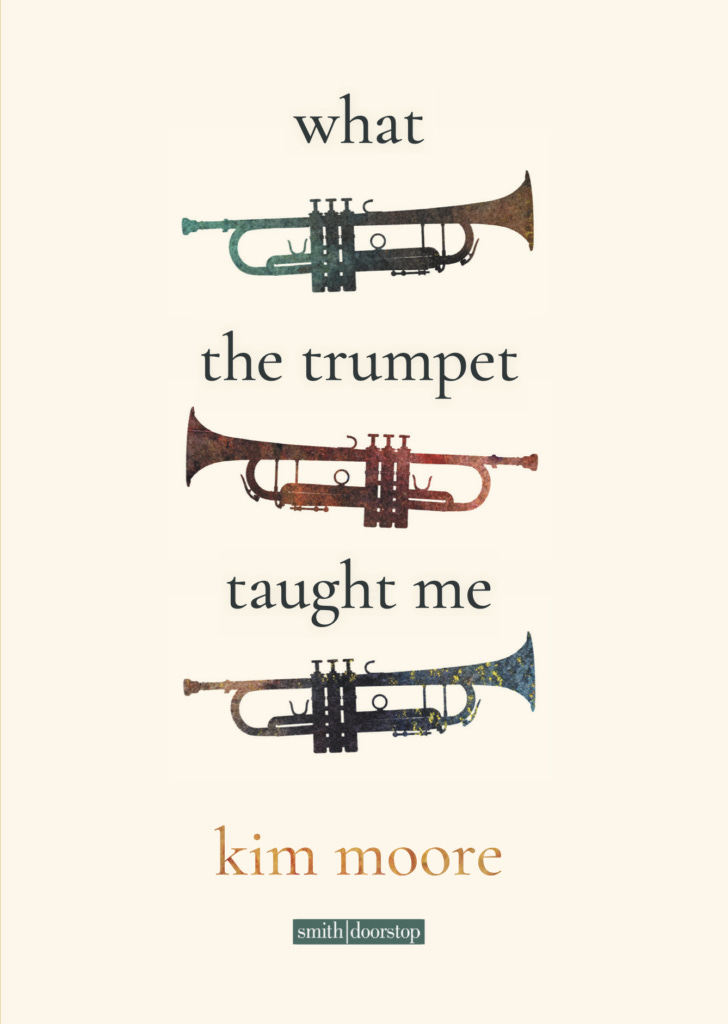In 2022, I published a strange little non-fiction book What the Trumpet Taught Me (Smith/Doorstop). I say it’s strange because I still don’t quite know what to call it - it’s part memoir, part lyric essay. It’s made of short prose fragments that sometimes break out into poetry. I’m planning to do a series of posts about this book, around ideas and permission, around drafting, editing and performance.
A few weeks ago I was interviewed for a forthcoming BBC radio show about people and their instruments. During the interview I felt like a little bit of a fraud - since moving to Hebden Bridge I haven’t picked up my trumpet. This was a conscious decision to try and make my life a little less busy when I moved. When I lived in Barrow, I was playing flugel horn in a brass band, and trumpet in a ten piece soul band. I’ve been here a year and a half now, and I’m just starting to miss playing. This sounds strange, but that yearning for me starts in my right hand - it’s like my right hand remembers the shape that it must make, the ‘C’ shape as it rests on the valves. Anyway, last night I was looking for a recording of myself playing the Last Post, or playing something to send to the interviewer (on his request) and I came across a recording of me playing and reading from What the Trumpet Taught Me alongside my twin sister Jody, and members of a local brass band in Maryport.
I wanted to share this video - partly because I didn’t know it existed, and also because I think it gives a good introduction to this strange, creaturely little book. When I wrote it, I imagined the text being interrupted by music in the performances of it.
There are different strands, or braids running through the book. One braid is a fragmented memoir that explores my working class background, and my childhood in brass bands, and my life as a trumpet player and a trumpet teacher. One braid is a story of the Last Post, both its history and my life-long relationship with it. One braid is a story about the two oldest trumpets in the world, and how one was lost, and how I also lost a trumpet, once upon a time. One braid is about teaching, and learning and how these two things are always interconnected and influence each other, even when they take place twenty or thirty years apart. There are braids about the physical act of making a trumpet. And one braid, the braid that you will hear a little of in this video, is a braid that is written drawing from the language of fairy tale, which I use to tell stories that are difficult, or painful, those partly healed wounds that our writing selves return back to, again and again.
I’m going to share the first part of this ‘braid’ here, and then do watch the video, which starts with a solo rendition of Concerto D’Aranjuez, before carrying on with the rest of the braid.
You will then hear a duet between myself and my sister, except I’m reading, and she’s playing the French Horn - again, when I wrote this section of the book, I imagined the text being interrupted by the music from Benjamin Britten’s Serenade for Tenor, Horn and Strings. The recording then cuts to a brief introduction to the Last Post, and then a rendition of it.
from WHAT THE TRUMPET TAUGHT ME
BY KIM MOORE
"ONCE UPON A TIME a girl and a man walked for two days in the wild. The man was a kind of teacher and had known the girl since she was ten, but she also thought of him as a friend, also thought of him as a kind of other-father.
The man bought a cheap second-hand trumpet. He said he wanted to learn, but really he bought it because he loved to hear the girl play, and he wanted her to play for him. The girl would not bring her precious cornet into the wild, and so the man bought his trumpet, not understanding the world of difference between the two instruments.
The man carried the trumpet for many miles in the wild, up and down hills, through bogs and streams and across stepping stones and bridges. The trumpet was wedged in his rucksack without a case, the mouthpiece and the leadpipe thrusting upwards from the opening of the bag, at a slight slant to the sky.
The man and the girl talked about poetry and music and university and language and not just what she wanted to be when she was older but who she wanted to be. They talked for hours as they walked and didn't notice that the sun had slipped away from the world and that dusk had arrived.
In the distance, lights from a far-away farmhouse blinked into existence. The man began unpacking the tent and handed the girl the trumpet. He told her to play something, anything. 'Play something Spanish,' he said and at first the girl protested. She was shy, nervous, worrying they would get in trouble somehow for making a noise in such a quiet place, but eventually she lifted the trumpet to her mouth and called across the hills. At the first note, farm-dogs started to bark and more lights came on in the distance. The man laughed and the girl smiled as they imagined the people, safe and warm in their houses, and what they might think of the strange sound floating in on the wind."I hope you enjoy this extract from the book - I’m tentatively thinking about getting back in practice again, so if anyone knows of any festivals that might like a unique performance from this book, where I can collaborate with local musicians I would be interested, so do get in touch!
I’ll leave you with a writing exercise which is to take something that has been important to you throughout your life, something that you’ve had some kind of relationship with, whether that has been sustaining or complex. This could be a musical instrument as I’ve done here, but another example of this is the wonderful, wild meditation on the colour Blue that Maggie Nelson carries out in Bluets, and which I would recommend as a book that creates language and space to write in my brain and heart every time I read it.
Once you have decided on your object, I want you to have a go at writing about it. Don’t worry about whether you are writing a poem or prose - it’s not important at this stage what we call the container these thoughts come in. If you want to, you can follow these three instructions which give you (hopefully) five ways of engaging with your chosen object
Write up to 500 words which talk about a particular day in your life with your object/thing
Write up to 500 words where you talk about how your object/thing is made - this may need research. Don’t be afraid to grapple with technical language in this part, and don’t worry about whether this is too boring/niche - these are all concerns for later!
Write up to 1500 words about your object/thing as a historical thing - can you find, or do you already know a story about your object in the past? In my case, I went back to Tutankhamun’s tomb, and into the history and symbolism of the Last Post. Choose the stories that speak to you - but don’t worry about how these things are connected.
By this time you may have a 1500 word essay built in fragments, or the starts of three poems, or the start of a whole memoir! Who knows. After you’ve written these first drafts, put them away and let them ‘cook’ in your notebook for at least one week. If you really want to look at them, resist the urge. This will hopefully build some urgency for when you do go back to them, and you will be able to see them with fresh eyes when you return.
I hope you enjoy writing!
If anyone would like a signed copy of What the Trumpet Taught Me, you can buy one direct from my website here. If you would like a copy of Bluets, it’s available from all good bookstores, but you can also support independent bookstores by ordering it from Bookshop.org here






This was wonderful to see and hear, thank you Kim. Everything- the music, the poems, the room, the colours. A strange, lovely island in today.
I loved this, thank you Kim. Since childhood I have started to learn various instruments; I have abandoned all but one or two fairly quickly.
You make me think I could start again …. though I may not …